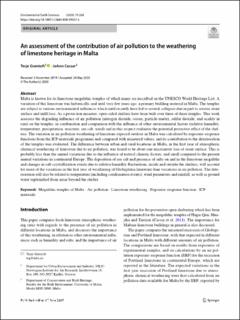| dc.description.abstract | Malta is known for its limestone megalithic temples of which many are inscribed on the UNESCO World Heritage List. A variation of this limestone was historically, and until very few years ago, a primary building material in Malta. The temples are subject to various environmental influences which until recently have led to several collapses due in part to serious stone surface and infill loss. As a protection measure, open-sided shelters have been built over three of these temples. This work assesses the degrading influence of air pollution (nitrogen dioxide, ozone, particle matter, sulfur dioxide, and acidity in rain) on the temples, in combination and comparison with the influence of other environmental factors (relative humidity, temperature, precipitation, moisture, sea salt, wind) and in this respect evaluates the potential protective effect of the shelters. The variation in air pollution weathering of limestone exposed outdoor in Malta was calculated by exposure–response functions from the ICP-materials programme and compared with measured values, and its contribution to the deterioration of the temples was evaluated. The difference between urban and rural locations in Malta, in the first year of atmospheric chemical weathering of limestone due to air pollution, was found to be about one micrometer loss of stone surface. This is probably less than the annual variations due to the influence of natural climatic factors, and small compared to the present annual variations in continental Europe. The deposition of sea salt and presence of salts on and in the limestone megaliths and changes in salt-crystallization events due to relative humidity fluctuations, inside and outside the shelters, will account for more of the variations in the first year of weathering of Globigerina limestone than variations in air pollution. The deterioration will also be related to temperature (including condensation events), wind parameters and rainfall, as well as ground water replenished from areas beyond the shelter. | en_US |

